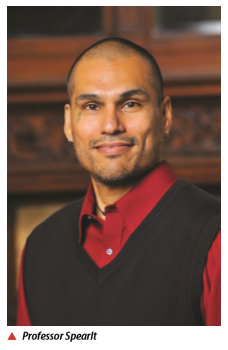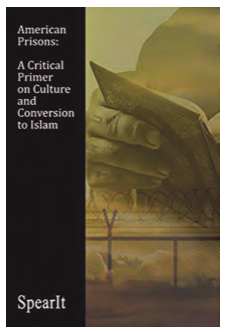By Juan Galvan
January/February 2020
Islamic Horizons recently talked with Professor SpearIt, author of American Prisons: A Critical Primer on Culture and Conversion to Islam (2017) and professor of law at Texas Southern University’s Thurgood Marshall School of Law.

He has taught for the Prison University Project at California’s death-row facility, San Quentin State Prison; taught corrections law at Saint Louis University School of Law; and serves on the advisory board of the Prison Program, which offers courses to both inmates and staff.
He is currently active in the American Bar Association’s Corrections Committee and its work to restore Pell Grant Funding for prisoners.
I.H. What can you tell us about Latino Muslims within the established Muslim prison communities?
P.S. A number of sources contend that Islam is growing among incarcerated Latinos. There are no reliable statistics about their number or denominational affiliation. I assume that a majority of them gravitate toward Sunni Islam, as is the case on the outside. I haven’t heard of any Latino Muslim-majority community in any institution, which suggests that their numbers are relatively small and most likely fold into the African American Muslim community.
I’ve heard of Mexican/Chicano gangs beating up converts for “betraying” the race. There are three factors at play here: (1) gang life often combines issues of race and religion; (2) their conversion is often accompanied by a cultural foray that provides direct insight into their cultural identity, including Arabic’s contribution to Spanish; and (3) a way to distance themselves from Christianity, especially Catholicism, and express their revulsion of its colonial legacy — including the penitentiary itself — in the Americas.
Religion sometimes inspires inmates to become educated and therefore better decisionmakers. Muslim prisoners have lower recidivism numbers than non-Muslims. One hopes that they will experience a similar success when transiting back into their communities.
Finally, we should start seeing more Latinos embrace the longstanding Muslim tradition of using the courts to sue prisons. Muslims generate the greatest number of religious complaints of any other religious group in prison. As more Latinos convert, I believe that we will see more Spanish surnames listed as the plaintiff.
I.H. What do you think about CAIR’s lawsuit, filed on Aug. 26 last, against the Los Angeles County Sheriff’s Department on behalf of three Muslim inmates — two of them Latinos — that alleges discrimination against Muslims in LA jails?
P.S. This is just one more case in the long history of violating the equal protection laws. In short, Latino Muslims are being forced to prove themselves the way African American Muslims did in the 60s and 70s — not because they are Latino, but because prisons continue to discriminate against all Muslims. Case law reflects the fact that incarcerated Muslims have always had to struggle to enforce their rights. The 1st Amendment says what it says, but that doesn’t mean that Muslims enjoy full rights. Although Islam has been deemed a “genuine religion,” prisons still classify some Muslim groups as SGT (security group threats), which means that they are disenfranchised of these rights altogether.
I.H. Are you familiar with the Latino Muslim Survey, which found that most Latino Muslims are female converts and that few Latinos embrace Islam in prison? Why do you think this is the case?
P.S. I would venture to say that Latinos view this more as an issue of cultural apostasy. Islam in prison is still viewed as a “Black religion,” so the infrastructure isn’t there in the same way. There is a legacy of Black prison converts, but not so much for Latinos. It’s different on the outside, where actual Latino mosques offer the type of support, resources and infrastructure that prisoners lack. We’re now are at the beginning stages, but I suspect that the numbers will keep increasing.
I.H. Do you think that African-American prisoners’ lack of da‘wah to Latinos is one reason why there aren’t many Latino Muslim prisoners?
P.S. Honestly, I think it’s more of an issue of the cultural constraints coming from Latinos themselves. Based on my correspondence with them, it seems that Black prisoners welcomed them and that prison was the place where some of the lessons of the Five Percenters, also known as the Nation of Gods and Earths, were translated into Spanish. Being Mexicano runs deeps, and for some this might seem to be incompatible with being Muslim.
I.H. Do you have any thoughts about “prislam” and Latino Muslims?
P.S. That term denotes the meshing of prison culture, gang attitudes, structures and mores with Islamic ideas. The current lack of Muslim chaplains creates space for prisoners to give khutbas and provide other services. Unfortunately, this opportunity is often twisted to advance criminal or other subversive behavior in the name of Islam.
This became more serious after 9/11, particularly because the feds’ refusal to let chaplains enter prisons created a leadership vacuum. State-level prisons often don’t have enough resources to hire qualified Muslim chaplains and thus must rely on community volunteers or prisoners to lead the services. I have advocated that prisons work with seminaries to turn interested prison converts into authentic Muslim chaplains; however, progress in this regard has been very slow.
I.H. Would more inmates convert if there were less prislam? Does the racial and ethnic segregation in prison result in fewer Latino Muslims converting?
O.S. And very quickly, yes. Latinos lack the natural groups within the Black prison community, where Islam is a prominent part. In some states like California, which segregate living quarters by race, it is much harder for them to enter the Muslim fold. I think that your question is right on.
I.H. Are there many White converts in prisons? If so, what’s their relationship with other Muslim prisoners?
P.S. Some Whites do covert, but to what extent this occurs remains unclear. I’ve heard of Aukai Collins (1974-2016), an Irish-American also known as Aqil Collins, who converted some time ago and authored My Jihad (2002). More recently Gregory Holt, a White Sunni Muslim imprisoned in Arkansas, won a 2014 Supreme Court case to grow a beard. He’s also involved in another case that’s before a federal appeals court. He is arguing that it’s unconstitutional to make all Muslims worship together because the Nation of Islam and the Nation of Gods and Earths are so different from Sunni Islam that Sunnis need their own worship space.

I.H. What kinds of resources are there for interested Latino prisoners?
P.S. State and federal prisons typically have libraries, many of which contain the Qur’an, the writings of Islamic scholars and other traditional works. Moreover, prisons usually have authorized distributors of religious materials — beads, oils and other items — that inmates can buy through authorized vendors. Prisons usually allow inmates to receive halal and other sharia-compliant foodstuffs from friends and family.
Schedules for formal religious services and other religious gatherings are usually posted. Some prisons insist that only Muslims can attend Muslim services, whereas others allow inmates to explore various faith traditions and attend multiple services during the week.
In addition, all sorts of courses, including Islamic and Arabic courses, can be done by mail if the prisoner can pay the necessary fees. I don’t know of any Latino Muslim community outreach efforts that specifically target Latinos.
I.H. What kind of resources would be beneficial?
P.S. Well, that may depend upon the prison system. For example, federal prisons tend to house immigration violators, more of whom speak Spanish as their first language. Thus, they would benefit from having more Spanish-language cassettes, books, magazines and so on.
Of course it would help if Congress reinstated Pell Grant funding for prisoners, for those funds could be used for vocational training and to train interested converts to become qualified chaplains and thereby fill in some of the leadership gaps both now and in the future.
Having access to the Internet would be a huge benefit, given the current dearth of available Spanish-language or Latino-directed materials. Prisoners cannot easily hit up Google, for prisons remain governed by archaic ways — including no Internet. Also, prisons could become more proactive by hiring qualified Muslim chaplains rather than relying on volunteers.
I.H. What would you like I.H. readers to know from your book?
P.S. That American prisons are an important piece of American Islam. Although the total number of Muslims in this country is small, the impact of Islam behind bars is the stuff of legend. In fact, prisons are an important part of Islamic history in America. As more Latinos learn about the history of Muslim Spain and other cultural links, Islam’s impact will continue to grow. I believe that Latino Muslims, following in the footsteps of their African American forbearers, are slated to usher in an Islamic renaissance behind bars.
Juan Galvan (latinomuslim.com), editor of Latino Muslims: Our Journeys to Islam, advocates for including Latino Muslim voices in the mainstream Muslim narrative. He encourages Muslims to learn more about this specific minority identity.
I have been reading out some of your stories and i can claim nice stuff. I will make sure to bookmark your site. Kipp Peyton Theran